In June of 2011, then-LucasArts president Paul Meegan spoke publicly about his plans for turning the company around. “In recent years, LucasArts hasn’t always done a good job of making games,” he said. “We should be making games that define our medium, that are competitive with the best of our industry, but we’re not. That has to change.”
Five years later, LucasArts is no more. The once-revered studio responsible for the production and distribution of Star Wars video games shut down in April 2013, and although the name lives on for licensing purposes, the developers are gone.
This story was originally published on September 28, 2013.
Promising games have been canceled, staff have been scattered, and Star Wars is now in the hands of Electronic Arts and DICE, where it will be used for a Battlefront reboot and an action-adventure game helmed by the studio Visceral.
Despite Meegan’s hopes, things never changed for LucasArts. And the company’s downfall is still a tough pill to swallow; LucasArts was a legendary establishment and the home to two of the world’s biggest franchises – Star Wars and Indiana Jones. What happened? Why haven’t we seen many great Star Wars games over the past decade? How did LucasArts fall apart?
Over the last five months, I’ve talked to a dozen people connected to LucasArts, including ex-employees at the company’s highest levels, in an attempt to figure out just how the studio collapsed. Some spoke off the record; others spoke under condition of anonymity. They told me about the failed deals, the drastic shifts in direction, the cancelled projects with codenames like Smuggler and Outpost.
They told me the stories behind the fantastic-looking Star Wars 1313 and the multi-tiered plans for a new Battlefront starting with the multiplayer game known as Star Wars: First Assault.
All of these people helped paint a single picture: Even before Disney purchased LucasFilm, the parent company of LucasArts, in November of 2012, the studio faced serious issues. LucasArts was a company paralysed by dysfunction, apathy, and indecision from executives at the highest levels.
“The bay area is filled with people who have had their hearts broken by LucasFilm or LucasArts,” said one person connected to the studio. “The sad legacy of multiple presidents, multiple layoffs… there’s a lot of people out there who’ve been treated badly by the company.”
LucasFilm declined to comment for this story.
Changing Goal Posts
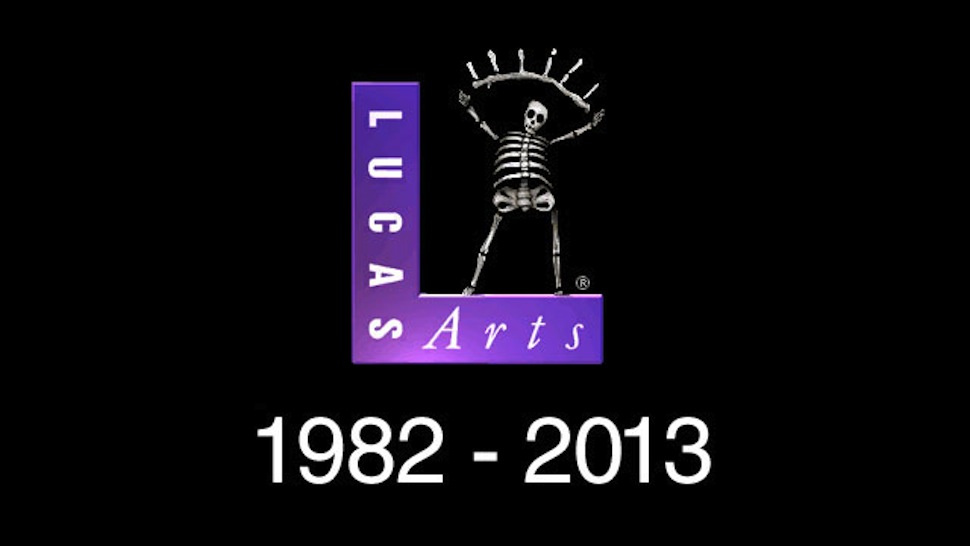
Every video game has to paddle upstream once in a while, but from the sounds of it, developing games at LucasArts was like swimming into a current.
In early 2009, a small team of LucasArts employees started working on a Star Wars game called Underworld, according to two people familiar with the project. Designed to complement an in-development television show of the same name, Underworld went through several early designs, including an open-world game with quests and other RPG-ish elements.
By the middle of the year, the project had evolved into a co-op shooter modelled after Gears of War, set during a period of time between the two Star Wars film trilogies. The game would unfold on the planet Coruscant, in the subterranean world of Level 1313, and like the TV show, it’d be grittier than anything we’d seen from Star Wars before: crime families, mature content, the works.
(The television show would be an “HBO-style adult-targeted drama,” according to a source, but it was never produced, and its status is still up in the air.)
The team started staffing up, and they put together early prototypes of the Underworld game, which some LucasArts employees jokingly referred to as “Gears of Star Wars.” But in mid-2010, when Paul Meegan took over as president of the studio, he didn’t think the game was innovative enough, according to a person familiar with the situation.
Some key Underworld staff agreed, and they rebooted again, this time transforming Underworld from a co-op shooter to a cinematic adventure inspired by the Uncharted action-adventure games. The Coruscant setting would stay the same, but the action would be totally different.
Per directive from George Lucas himself, the game’s protagonist would be a bounty hunter – a generic jack-of-all-trades without the Jedi powers that usually took centre stage in Star Wars games. Instead of swinging lightsabers and using the Force, players would manipulate gadgets and capture bounties for cash. Team members were psyched about the new direction for the project, which they called 1313.
But the goal posts kept shifting, ex-team members say. Every so often, Lucas would check in with the team, and as he grew to trust the staff behind 1313, he’d offer up changes, asking them to switch characters and rewrite the story based on what he felt would be more fitting for the game.
Ex-LucasArts staff describe Lucas as someone who cared deeply about telling stories, but didn’t know much about the game development process – every Lucas-mandated story change meant shifts in every department: the design, the art, the programming. How could that not be frustrating?
“One of the problems of working in a film company – [Lucas] is used to being able to change his mind,” said one source. “He didn’t really have a capacity for understanding how damaging and difficult to deal with these changes were.”
In 2012, just eight weeks before E3, George Lucas dropped a bombshell: instead of starring a generic bounty hunter, 1313 would be helmed by the iconic mercenary Boba Fett.
Some staffers tried to push back – they’d spent over two years working under an entirely different vision – but Lucas and his team of executives wouldn’t reconsider. They wanted a game with Boba in it. On top of that, according to two people familiar with the project, 1313’s developers were prohibited from talking about the new hero. When the devs revealed the game and started taking interviews during E3 2012, they had to pretend that 1313 starred the same generic bounty hunter it had for the past two years.
It was a tough situation for the 1313 team, as they also had to be vague about which platforms the game would be on; at that point, Sony and Microsoft were still not acknowledging that they were working on new consoles, and given that this was a game for PS4 and Xbox One, the developers had to dodge questions while trying to hype up their newly-announced title.
(One source corroborated a rumour I’d frequently heard at E3 2012 – Microsoft and Sony were peeved at both LucasArts and Ubisoft for prematurely showing off what everyone assumed would be their next-gen games, 1313 and Watch Dogs, before next-gen consoles had been officially announced.)
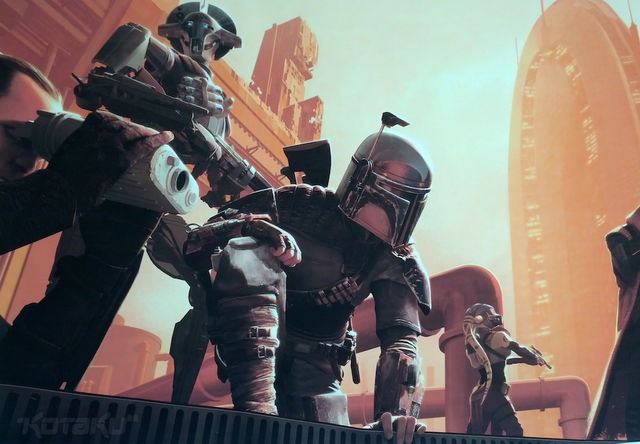
Still, fans and critics loved what they saw from Star Wars 1313 – the sizzling demo videos showed impressive technology and extravagant set-pieces that seemed like what everyone had always wanted from a Star Wars game.
When the team got back from E3 in June of 2012, they were pumped. They had a plan in place – ramp up hiring, double down on production, and make the best damn Boba Fett game they could make. They added new gadgets – a jetpack, flamethrowers, wrist rockets. Things seemed good.
Although some saw 1313 as an Uncharted clone – and even today, that’s how some people look at the cancelled game – one person familiar with development of the game emphasised that the newly-implemented jetpack changed the design entirely, adding a vertical element to the action and platforming that gave things a fresher feel. Even George Lucas was high on the project, especially after the E3 acclaim.
Then, in September, everything changed. LucasFilm enacted a hiring freeze, according to four people who were there at the time. All marketing plans were halted, and the company went into silent mode. Production continued on Star Wars 1313, but without the capacity to continue hiring the staff they needed, the team was crippled.
The freeze also led to endless questions revolving around Star Wars: First Assault, a multiplayer shooter that had also changed shape multiple times since it first began development in 2010. Created because George Lucas wanted to compete with the gargantuan Call of Duty series, First Assault was originally a large-scale shooter set in a time period after Return of the Jedi, according to two people familiar with the game.
Then, following direction from executives at LucasFilm, the game moved back to the Clone War era. This was a common theme at LucasArts, sources say – First Assault, which was code-named Trigger, shifted and evolved because of ever-changing direction, just like 1313. The goal posts just kept moving.
Trigger eventually morphed from attempted Call of Duty killer to multi-step project designed to reintroduce Battlefront to the world. The first game, First Assault, was set to be unveiled in September of 2012 and released in the spring of 2013. The second step was a project called Version Two, designed to show off vehicle prototypes and other Battlefront elements that didn’t make it into First Assault.
Below you can see footage of Version Two, which according to one source grew from the remnants of a project code-named Wingman that was going to be a Wii U title modelled after the old TIE Fighter and X-Wing games.
But when LucasFilm enacted the hiring freeze, they also put the brakes on those marketing plans. Nobody could talk about First Assault, even when the box art was accidentally revealed on Xbox Live at the end of September.
People were baffled. “Everyone took it badly when we were told we couldn’t announce or do our beta,” said one former member of the First Assault team. They kept working, but ex-First Assault staff say they had no clue whether or not the game would actually come out.
A month later, it all suddenly made sense. On October 30, 2012, Disney announced that they had purchased LucasFilm. The acquisition had been in place for quite some time, and LucasFilm had enacted the freeze in preparation for the reign of Mickey Mouse.
Yet the hiring freeze didn’t end. And over the next few months, even as LucasFilm made public declarations that everything was “business as usual,” staff started to leave the company, and morale was low.
When LucasArts shut down, both Star Wars 1313 and Star Wars: First Assault were cancelled. It was a heartbreaking experience for those still with the company. And it wasn’t the only one.
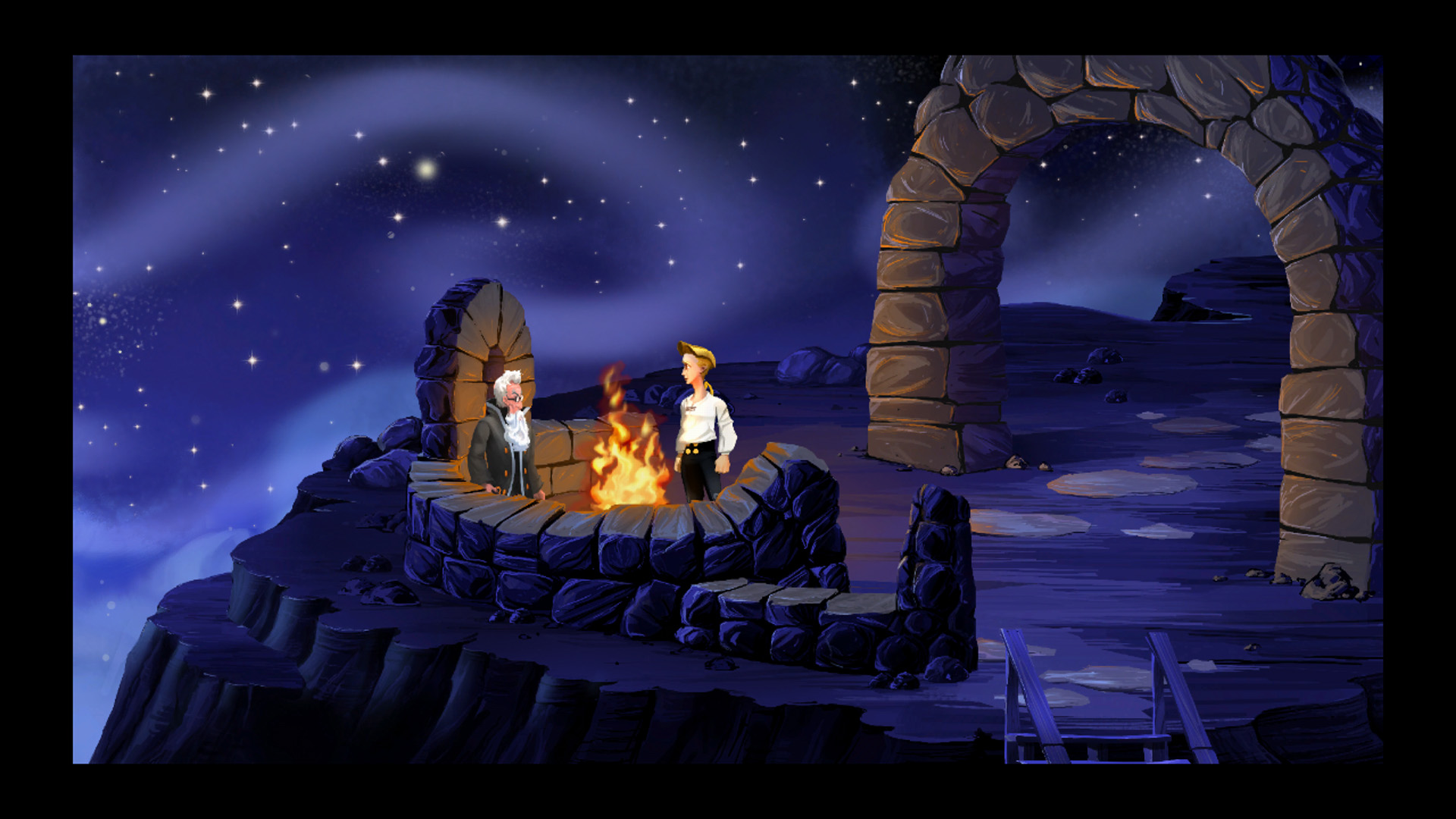
Opening The Vault
It’s impossible to pinpoint a single reason for the demise of LucasArts, but an outside observer might look at the revolving door of presidents – three in the four-year period between 2008 and 2012 – and wonder how anything got done. Instability ruled the realm; every high-level turnover came with layoffs and cancellations and a total shift in company direction led by whoever would take over next.
Some ex-LucasArts staffers lay blame on the presidents themselves. Others finger executives at LucasFilm for refusing to take the risks needed to make games that people would consider worthy of the Star Wars name. A number of ex-LucasArts staffers pointed to Micheline Chau, who was president of LucasFilm up until September of 2012, as the main factor for the company’s decline – and the explanation for the revolving door of LucasArts presidents.
Sources describe Chau as the gatekeeper for George Lucas, and two high-level ex-LucasArts employees both said she had a tight control on Lucas’s schedule. She would run rehearsals with the staff before they could meet with Lucas, sources said, and she would micromanage what the team could say and when they could say it.
“[Lucas] understood the nature of play – and games – but we didn’t have the time with him that we needed,” said one person familiar with high-level meetings at LucasArts.
“It never felt like people at the top cared about making great games,” said another person connected to LucasArts. “A lot of awesome projects never went anywhere because, ‘it’s not gonna make enough money.’”
Take the case of “Star Wars GTA,” for example. During the early days of the 1313 project, some top staff at LucasArts wanted it to be an open-world, Grand Theft Auto-style Star Wars game set on Coruscant, according to two people familiar with that project. It was a fantasy for many on the team, and the thought is enticing – who wouldn’t want to explore and cause mayhem in a world full of seedy bounty hunters and Star Wars crime families?
Looking at their contemporaries at Rockstar and Ubisoft, LucasArts staffers plotted out how many people it would take to build a game like that – hundreds – and how much money it’d cost – millions. That was too much of a risk for the executives at LucasFilm, sources say.
“Of course there was no appetite to make that kind of investment,” said one person familiar with goings-on at LucasArts. “That idea kinda came and went literally within the span of two months.”
Later, when Far Cry 2 designer Clint Hocking joined LucasArts, he and a small team spent a year and a half designing their open-world game – a “wonderfully complex game driven by choice and consequence” that never quite got the resources it needed, according to one person familiar with Hocking’s project. That project was also cancelled, and Hocking left the company in mid-2012.
In 2009, just before starting work on Underworld, LucasArts axed an Indiana Jones game for Xbox 360 and PS3 that had been in development for years, according to people familiar with the project. The company also shut down a 2D physics-based shooter called Caveland that was meant to be an experimental digital title, like the sidescroller Lucidity before it.
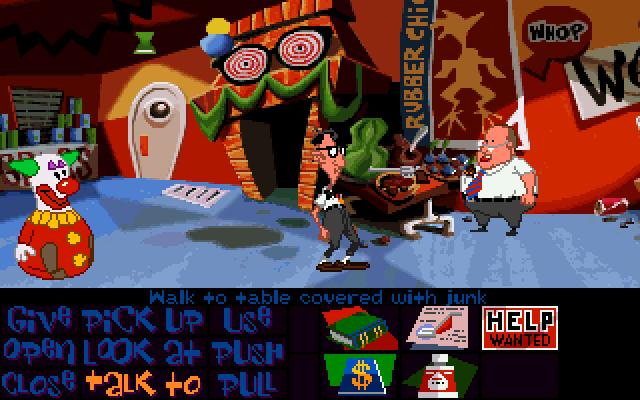
In news that will certainly crush anyone who enjoyed LucasArts-branded adventure games, the team at LucasArts Singapore was working on a remastered version of the classic point-and-click game Day of the Tentacle, according to three people familiar with that project. Like the special editions of the first two Monkey Island games, released in 2009 and 2010, the remastered Day of the Tentacle would be pseudo-3D, with remade background art and cut-scenes redone to run at 30 frames per second.
Although this Day of the Tentacle remake was never officially greenlit, two sources say it was almost finished. One person familiar with the project pegs it at 80% done.
But it was never approved, and the company’s higher-ups had no interest in continuing to make what they called “legacy” titles like this one. So the game remains unreleased – and perhaps there’s a near-finished Day of the Tentacle HD sitting on a shelf somewhere in Singapore, never to be touched again.
It’s devastating. Day of the Tentacle, a hilarious point-n-click adventure that did the whole three protagonists thing years before Grand Theft Auto even existed, is almost impossible to purchase legally today. This is a game that deserves a digital re-release.
“For many involved this was a dream project,” said one person who worked on the game. “But sadly, like many, many LucasArts games in development, it never saw the light of day.”
The list of cancelled projects goes on and on. There was Smuggler, a game designed for cross-platform multiplayer that would let you play as a customisable character within the Star Wars universe, smuggling and trading between Facebook, tablets, and consoles.
There was Outpost, the Star Wars take on Zynga’s FarmVille that would let players build empires, one click at a time.
There was Death Star, the iOS game in which you’d get to control your very own version of the Empire’s iconic space station.
There was the online service that would be LucasArts’ very own version of Origin, EA’s network for distributing games and servicing online multiplayer. Like Origin for EA, this LucasArts-branded network would help the company distribute Star Wars games and in-app purchases. According to one person familiar with plans for this network, it would have launched alongside Star Wars: First Assault, which would have had some sort of microtransaction store.
All of these games were connected, and they were all part of one big ecosystem, according to people familiar with goings-on at the company. Eventually, as seemed to be a pattern at LucasArts, they were all axed. Of course, cancellations are not abnormal in the iterative world of game development, where projects shift and disappear all the time. What made LucasArts different was the studio’s tendency to cancel finished projects – games like Death Star and Outpost had already gone through QA testing and were very close to being shipped, according to two sources.
“Projects get canceled all the time,” a person familiar with LucasArts said. “You’d hope that your process can identify problem projects before they’re finished.”
So LucasArts spent most of their final years concentrating on two big games – 1313 and First Assault – and the smaller project, Version Two.
“Every couple of years, George Lucas would get re-engaged for a period of time,” said another person connected to LucasArts. “The whole company would pivot around George’s interests. And then it would fizzle out.”
The Deal That Fell Through
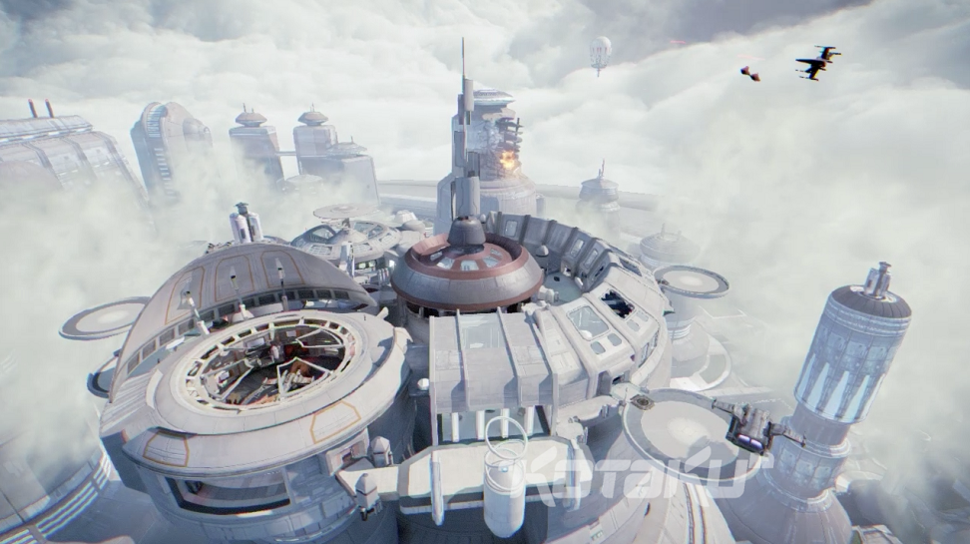
Could LucasArts ever have been saved? Rumours came hot and heavy following the shutdown, and in April, I reported that EA had considered buying the storied studio up until a combination of factors – like the SimCity disaster and CEO John Riccitiello’s departure – led to the deal falling apart.
More people have come forth to corroborate those EA negotiations, and according to two high-level sources, EA’s deal would have financed both 1313 and First Assault – LucasArts would’ve stayed where it was, working under EA supervision.
According to one person familiar with goings-on at LucasArts, other big publishers considered buying the company as well.
“There were various things on the table,” said that person. “Buying 1313, buying the studio, just doing a deal for that game. Multiple people made offers to help finish and publish 1313.”
One publisher made an offer that was “above the budget of 1313,” according to a person familiar with negotiations, but LucasFilm wouldn’t take the deal – licensing out a game like Star Wars 1313 just didn’t mesh with their strategies for the upcoming movies, and some top executives were much more interested in putting together a next-gen Battlefront, which EA would go on to commit to.
In hindsight, it’s become rather clear that Disney never wanted to keep LucasArts as it was in 2012 – on the day of the LucasFilm deal, Disney CEO Bob Iger said in a conference call that his company would be “likely to focus more on social and mobile than [they would] on console,” referring to console video games like the ones made at LucasArts. Still, most staff remained with the company, swimming onward against the current.
Three different ex-LucasArts employees have told me that in March of 2013, staffers were told they’d “be taken care of” – that is to say, they didn’t have to look for other jobs. This was because higher-ups at LucasArts were convinced that the EA deal was coming together, even when it became clear that Disney had no interest in financing their games.
Still, some saw that the end was near – especially when employees were told not to mention Star Wars: First Assault by name even after I’d published details about the game on Kotaku – but up until the last day, there was hope.
The Letter
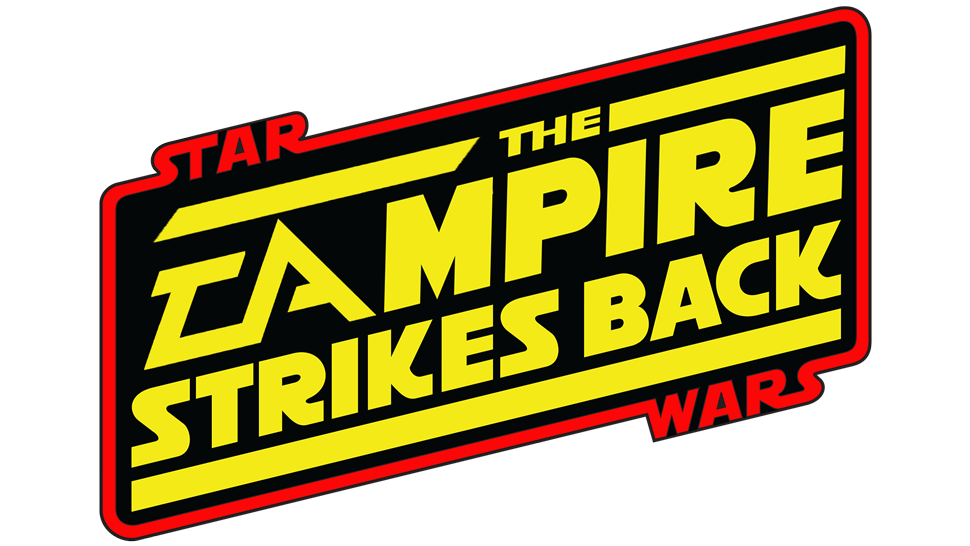
On April 4, 2013, the day after LucasArts shut down, Star Wars 1313 creative director Dominic Robilliard sent an e-mail to his team. I want to share the whole thing here:
I had hoped that I could address you all face to face as usual, but it seems that we are already scattered to the winds and the chances of a well attended gong meeting are slim! It’s probably for the best as I’m not sure I could get through what I have to say to you all and keep it together.
When I look back on the last couple of years making this game I cannot believe what we achieved under the circumstances we had to deal with. It really is astonishing. Re-directions, interference, unstable management and studio leadership; sometimes I just can’t believe you have stayed with me, and more importantly still deliver such an incredibly high quality of work. I cannot tell you how proud I am of every singer game-maker on this team. I will be in your debt for the rest of my career.
Here at the end of all things, with lies and mis-information leaking into the press from understandably malcontented folk elsewhere, I wanted to focus on the truths of what we had. Let’s start with you the team, the most prized and valuable asset of this whole endeavour. Great teams make great games and you have proved it over, and over again.
Every challenge, from every unforeseen angle has been met with conviction and despite the number of times I had to stand in front of you with challenging news (the toughest part of my job) I knew that you would deal with it and stand with me to overcome. I can’t tell you how much that meant to me each and every time I had to do it.
So, why did we do it? Because the game is truly fantastic. One of the things I am most sad about is that on a gameplay level all that exists of our game out in the wild is our basic cover combat and platforming. This beautiful and broad systemic play space which the design, animation and engineering team created so diligently over the last year (and that wowed every external person who game in to play the game) won’t see the light of day.
We set out to create the ultimate Star Wars Bounty Hunter fantasy, and we achieved it. The jetpack was the final piece of the puzzle and suddenly I think everyone across the team really saw how the liberating combination of bounty hunter gadgets and environmental freedom created something truly unique, and something that doesn’t exist in our genre right now. You should all be so proud of what you created. It is amazing.
The area of development I’ve probably learnt the most in is the visual development of the game. Our spectacular and truly world-class art and rendering team has delivered every day for the entire process. I can’t thank the art department enough for embracing me through this process and helping to educate my eye. There can be no debate (and there wasn’t last year at our announce) that the game looks anything other than stunning. All of the effort and consideration that went into our carefully and lovingly constructed look was so worth it.
We wanted to achieve a take on the Star Wars universe that melded with the original trilogy and it was received in exactly that frame of mind. I lost count of how many publications and interviewers at E3 said that Star Wars 1313 was literally the ‘best thing they had ever seen’.
I’ve never worked on anything that has drawn that level of praise. The rendering technology and performance capture work developed by this team with Kim at the helm repeatedly left me slack-jawed on a near daily basis. There was a lengthy period leading up to the E3 demo where it is no lie to say I saw something new every day that I hadn’t seen before. I felt so blessed and lucky to be in that position – so again, thank you.
E3 last year was one of the greatest highlights for us all. I’m so glad that we fought tooth and nail to make that debut, and more importantly to make sure that it was real. Real gameplay, real (time) visuals and from a genuine part of our game. Many people doubted that we could do it: pull together all these threads of gameplay, technology, art, cinematics into something so compelling and exciting. Working on the very edge of what was possible, using technology that was being invented as we went through the process (!) was so thrilling, and thankfully was worth every second of effort we put into it.
That pressure made a diamond and it became the backbone of our game, as was intended. We proved that a true collaboration between games and film was possible (in a way that never was before) and our cinematic, rendering and performance capture tech truly does live in both worlds which is an amazing feat. I continue to believe in this approach for the future.
As we move on with our lives, please don’t forget the response we got from the world last year: 31 Awards and Nominations! The press was better than we ever expected too. Who would have thought that we could have turned so many LucasArts detractors into believers? It really was so satisfying.
Turning this studio around at a team and game level has always been something that has kept me going, despite any turbulence above us. Making the greatest Star Wars game that has ever been made has been my biggest dream since I was a kid and I truly believe we were on that path. You can tell from the outpouring of support across the internet that other people believed it too. Pete and I always knew that getting momentum with jaded Star Wars gaming fans was going to involve a lot of humility, patience and ultimately hands on proof that we were who we said we were.
I talked at a number of points during interviews over the last year that we were ‘on probation’ with gamers – and I meant it. Again I’m just so sad that your integrity and humility in seeing the world that way with me is not going to be paid off with the joy of turning those sceptics into fans, and giving the loyal supporters we have amassed what they deserved: the best Star Wars game ever made.
I have plenty more to say, and so much more gratitude to show you all but right now it’s too hard to articulate it. I genuinely care for everyone on this team and hope desperately that we will work together again someday. I will look forward to that day.
Until then I will dedicate all my time and energy over the coming months to making sure that anyone who is thinking of hiring a Star Wars 1313 team member knows that they will be making an amazing investment and the smartest decision of their career.
You are the greatest team I have ever known and I love you all,Dom
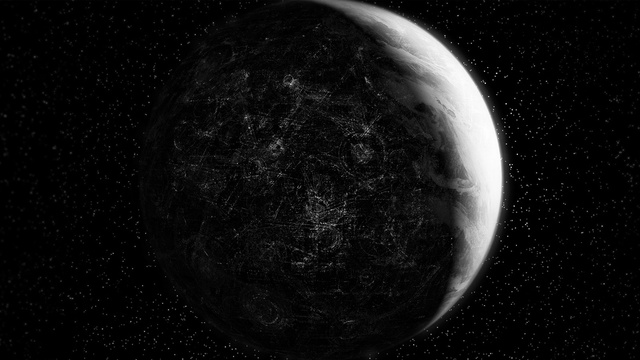
Perhaps you were dazzled by Star Wars 1313 last year. Maybe you grew up playing iconic LucasArts adventure games like Monkey Island and Grim Fandango. You might fondly remember a golden era packed with popular Star Wars games like Rebel Assault and Jedi Knight. Maybe you’ve played one of the many, many other great games developed by people who used to work at the company once known as LucasFilm Games.
Even today, as evidenced in a LucasFilm video that made the rounds last week, technology from Star Wars 1313 is still being used. According to two people familiar with goings-on at the company, the 1313 engine has already been used for film cinematics, and LucasFilm plans to use it in the seventh Star Wars movie, which will be out in 2015.
And … the future of Star Wars games might be better than it’s been in a long time. One ex-LucasArts employee told me they think the franchise is in more competent hands under EA than it ever was with LucasFilm. Others are hopeful for the future of Battlefront, Visceral’s action/adventure game, and whatever else will come in the future, both from Star Wars and the many talented people who left LucasArts behind.
“George once told us: be the best, stay small, and don’t lose any money,” said Monkey Island creator Ron Gilbert in an e-mail. I’d asked him for some thoughts about his time there, during the company’s heyday, when he and other iconic developers like Tim Schafer and Dave Grossman put together some of LucasFilm’s most beloved games.
“That was our mission,” Gilbert said. “Working there was like being part of a creative Cambrian explosion. We feed off the creativity of each other and dreamed whatever we dared. We were free of market pressures, yet we all wanted to make games that sold well. We wanted to make games that a lot of people played and loved. We were passionate and naive and idealistic. Maybe Lucasfilm Games was just a perfect storm. The right people in the right place at the right time. Whatever it was I am proud, honoured and humbled to have been a part of it.”
LucasArts could never quite save itself. Too much dysfunction, too much indecision, too much apathy toward video games. Yet the company’s legacy will always live on.
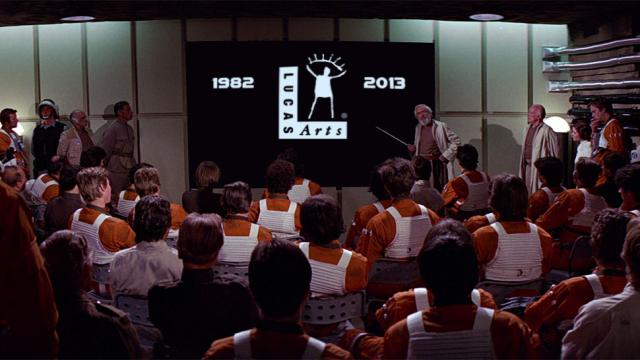
Comments
19 responses to “How LucasArts Fell Apart”
Like many others I’m sure, it’s not the star wars games I’ll miss – but the incredibly clever and now dying genre of point and click adventures. I remember playing Loom, Indiana Jones and The Last Crusade and Monkey Island as my “main” PC games when I was growing up and they really helped shaped my gaming future.
Their collapse is sad. Oh well at least the Armikrog kickstarter made it!
I don’t really trust EA with the star wars license. One look at the trail of corpses they have created of IPs they have purchased or created is enough for me to mourn the death of good star wars games.
You dont trust the largest publisher of video games in the world, a company that has tons of mega-IP’s and makes some of the finest games ever made? I really don’t like how everyone just sheeps into hating on EA for no reason.
I would hardly call it no reason. EA has made a living in buying companies and profitable IPs and then churning out junk games, filling them with cynical attempts at increasing profit, while decreasing the value of the franchise until it has zero value, at which point they bin it and move on to the next one. And this is only one of the issues I have with them.
Underfunding small companies and issuing unrealistic goals that result in the company being unable to repay the investment and allowing EA to buy out the company cheap before shutting them down and firing/reassigning the staff. Buying and hoarding IP’s with no intention to develop them so no one else can. Bribing reviewers. I could go on all day.
No reason huh
Yes, they make excellent use of their purchased IP. Look at Wing Commander… uh, don’t worry. But then there was Command & Conquer… let’s move on. Sim CIty was… never mind. The Ultima games… we may get another one day. Mythic made The Warhammer MMO… wait, that’s about to shut down.
In fairness, they haven’t screwed up all their franchises. Bioware still have some good output, as do Criterion. If you like expansion packs for The Sims you’re probably very happy. And of course they produce loads of sports titles, many of which are supposed to be pretty good, even though the latest FIFA for some platforms is only a roster update from what I’ve heard.
The fact that the first KOTOR game was made by Bioware under EA is a point in their favour.
The largest does not equal the best. Their past successes are well and truly in the past and the publishers greed has taken the better of them. EA has shown time and time again that they are just after peoples pockets.
“I really don’t like how everyone just sheeps into hating on EA for no reason.”
No reason? You’ve got to be kidding.. Go educate yourself a little. Criterion, Bioware, Maxis, DICE, Bullfrog and the list goes on.
All that is only the start of a long list of reasons of why people could possibly hate EA.
Sim City 4.
I’m not going to join the chorus of people downvoting you. I’m just going to assume you’re unaware that there is legitimate reasons from people. It’s not just a dog pile.
Personally, I don’t consider what happened to Westwood Studios or Bullfrog “No reason.”
I think it was downhill for Lucasarts since KOTOR 2
Didn’t they license that out to BioWare? If they did it wouldn’t really have been a LucasArts game
KOTOR 1 BioWare, 2 was Obsidian. But yes, it was only published by LucasArts, not developed.
I loved Tentacle as much as the next person, but I never got into any of their other IP’s during that era. Hell I didn’t even know they still existed until I played the Battlefront games a decade later. Those were some sweet sweet Star Wars.
So George Lucas continues to f*ck the Star Wars universe so many years after creating it? I’m happy to have enjoyed the golden years of Lucasarts. While I’ve been playing games since the Atari 2800, those Lucasarts games in the 90’s showed what was possible with true story telling in games.
So… would you say LucasArts had bad Trigger discipline?
I’m sorry, I’ll go now.
Personally, I’m mourning the death of 1313, that game looked amazing
Is it just me or do the dates at the start of the article not line up..??
Then
Minor quibble, but it annoys me.
Blame the four years part on me, although the rest was just how it was originally written. I’ve fixed it up now and that passage should be a touch more readable.
Just another reason why I’m glad Old Georgie Boy isn’t in charge any more. He created a great universe and then proceeded to mismanage it.